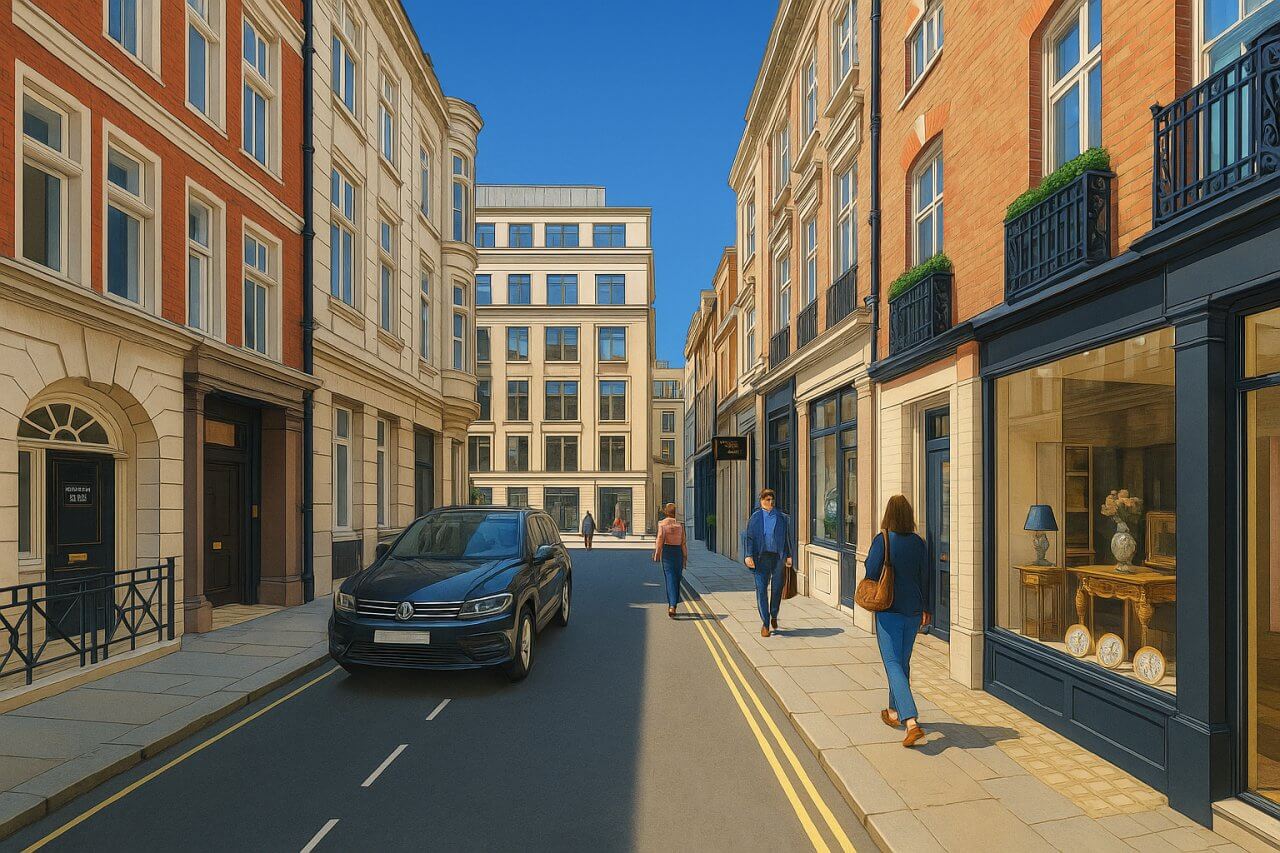
Bury Street, London
Bury Street is a short but historically significant road in the heart of St James’s, in the City of Westminster, central London. With its elegant Georgian façades, discreet art galleries, and exclusive private residences, Bury Street is a quintessentially British street tucked between Jermyn Street and King Street. Despite its modest length, the street boasts a prestigious past and is surrounded by some of London’s most refined cultural and commercial destinations.
Location and Layout
Bury Street is a narrow one-way street running in a south-to-north direction. It begins at King Street to the south and ends at Jermyn Street to the north. Its total length is approximately 120 metres (roughly 394 feet). The street is intersected twice by Ryder Street, which meets Bury Street in two short, disjointed junctions on either side.
Vehicular traffic on Bury Street flows one-way from King Street to Jermyn Street. This regulation helps preserve the quiet, residential character of the street, reducing through traffic and enhancing its appeal as a peaceful enclave in busy Westminster.
History and Name
Bury Street dates back to the late 17th century, when the St James’s area was first developed into a fashionable district for the British aristocracy. The area was transformed during the reign of Charles II following the construction of St James’s Square and surrounding streets. Bury Street was part of this carefully planned urban development that emphasized symmetry, grandeur, and neoclassical style.
The name “Bury Street” is likely derived from a personal name or title, possibly referencing a landowner or place of origin. One possibility is that it refers to the town of Bury St Edmunds in Suffolk, a known noble connection in English history. The street name has been in recorded use since at least the early 18th century. It is pronounced “Berry Street”, despite the spelling. The phonetic pronunciation is /ˈbɛri/. 
Character and Atmosphere
Bury Street is known for its discreet elegance and historic charm. The architecture reflects a blend of Georgian and Edwardian styles, with several Grade II-listed buildings lining the road. Many of these structures now serve as galleries, private clubs, or high-end residences. The ambiance is quiet, refined, and conservative, catering to art collectors, professionals, and affluent residents.
What to See Nearby
Though Bury Street itself is small, it lies at the heart of a culturally rich district. Within a short walking distance, visitors can explore:
- Jermyn Street – Known for its traditional men’s tailors, shirtmakers, and luxury goods.
- St James’s Square – A green and elegant square surrounded by private clubs and historic buildings.
- The Royal Academy of Arts – Located on nearby Piccadilly, a leading institution of visual art.
- Christie’s Auction House – Just around the corner on King Street, one of the world’s most prestigious auctioneers.
- White’s Club – One of London’s oldest and most exclusive gentlemen’s clubs, accessible from St James’s Street.
Real Estate
Properties on Bury Street are among the most exclusive in Westminster. As of 2025, residential properties here typically range between £2.5 million and £6 million, depending on size, specification, and heritage status. A typical flat measuring 1,500 square feet (approximately 139 square metres) may command a price close to £4 million, with penthouses and period houses reaching higher figures.
Compared to the wider London average, which is around £700,000 for a flat, Bury Street is firmly positioned in the top 1% of the capital’s property market. The area is sought after for its location, heritage, and discretion, attracting diplomats, art dealers, and international investors.
Transport Connections
Nearest London Underground Stations
- Green Park Station – Served by the Jubilee, Victoria, and Piccadilly lines. Approximately a 6-minute walk from Bury Street.
- Piccadilly Circus Station – Served by the Bakerloo and Piccadilly lines. Roughly 8 minutes on foot.
- Charing Cross Station – For access to the Northern and Bakerloo lines, and National Rail services. About a 12-minute walk.
Bus Routes
The nearest bus stops are located on Piccadilly and Pall Mall, both less than 5 minutes’ walk. Key bus routes in the area include:
- Route 9 (Hammersmith to Aldwych)
- Route 14 (Putney Heath to Russell Square)
- Route 22 (Putney Common to Oxford Circus)
Fun Fact
Bury Street was once home to the famed satirist and essayist Jonathan Swift, author of Gulliver’s Travels, who briefly lived there during the early 18th century. His time on Bury Street is noted in biographies that document his time in London among literary and political circles.
Quick Facts
- Location: St James’s, City of Westminster, London
- Length: Approximately 120 metres (394 feet)
- Traffic Direction: One-way (south to north)
- Connects: King Street to Jermyn Street
- Intersections: Two disjointed junctions with Ryder Street
- Pronunciation: “Berry Street” /ˈbɛri/
- Nearby Attractions: Jermyn Street, Royal Academy, Christie’s Auction House
- Architecture: Georgian and Edwardian style
- Property Prices (2025): £2.5M–£6M; ~£4M for 1,500 sq ft (139 sq m)
- Nearest Tube: Green Park (Jubilee, Piccadilly, Victoria)
- Nearby Bus Routes: 9, 14, 22
- Historical Note: Once home to Jonathan Swift
Map of Bury Street, London

Painting of Bury Street, London (View image in full size)